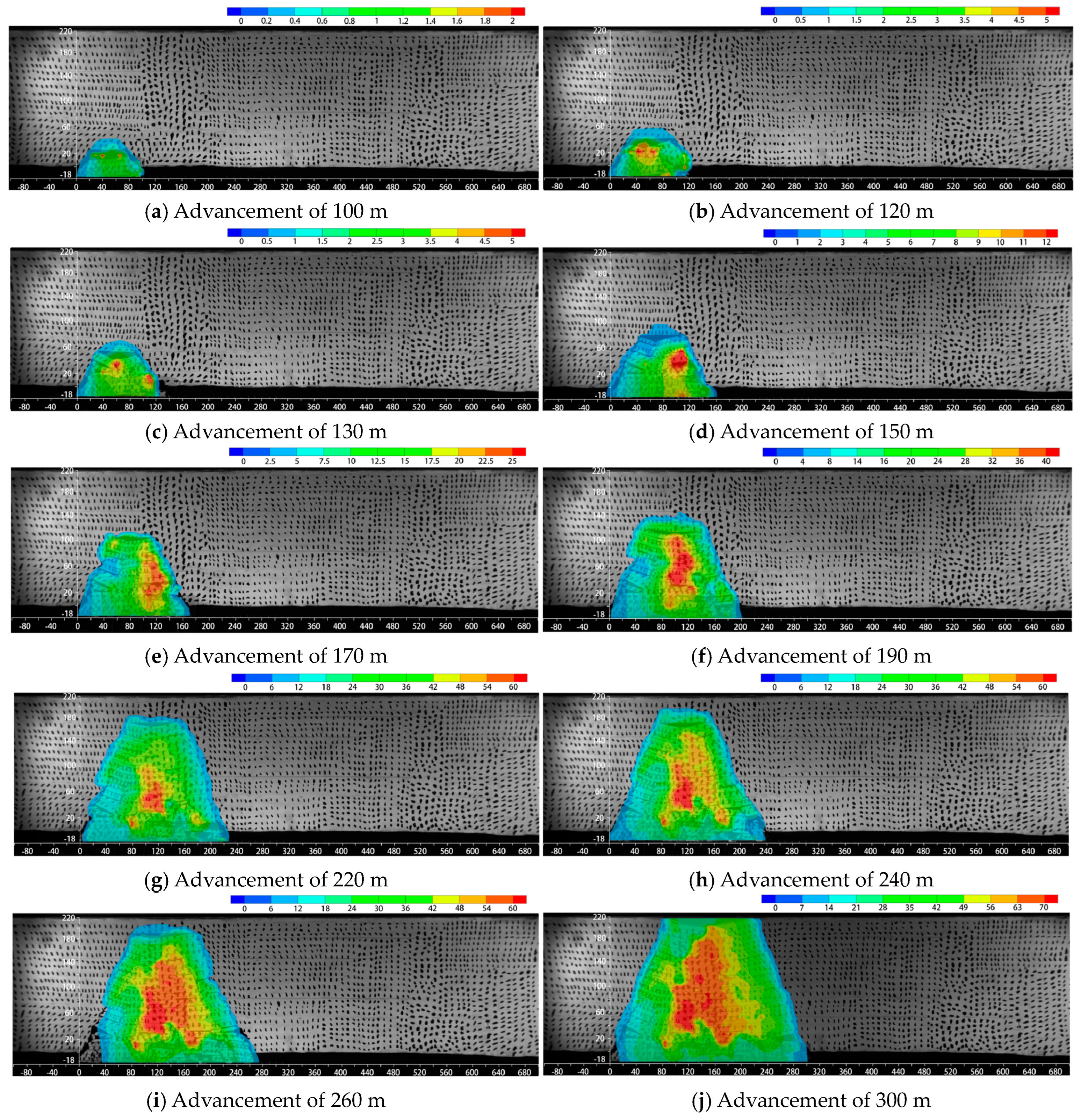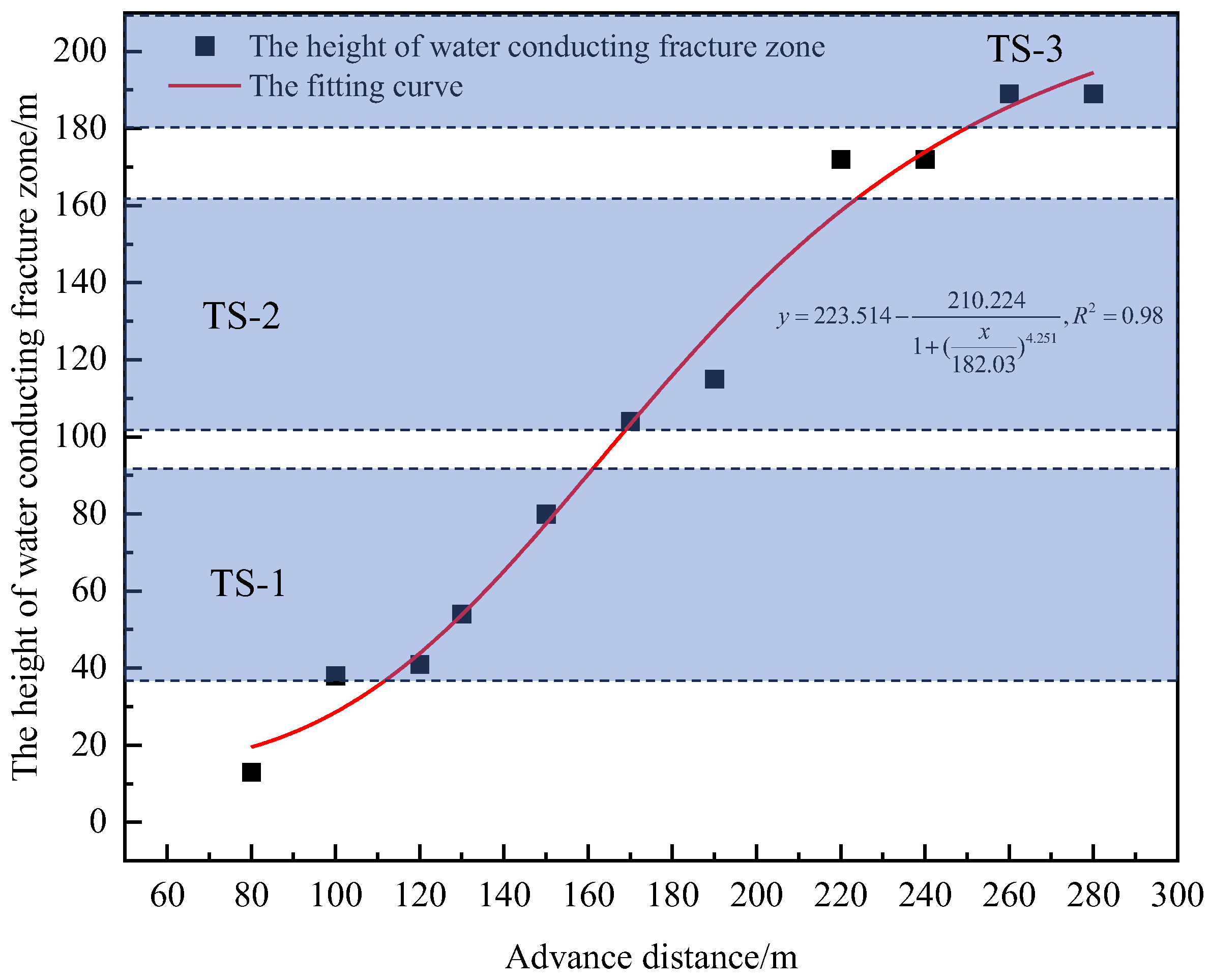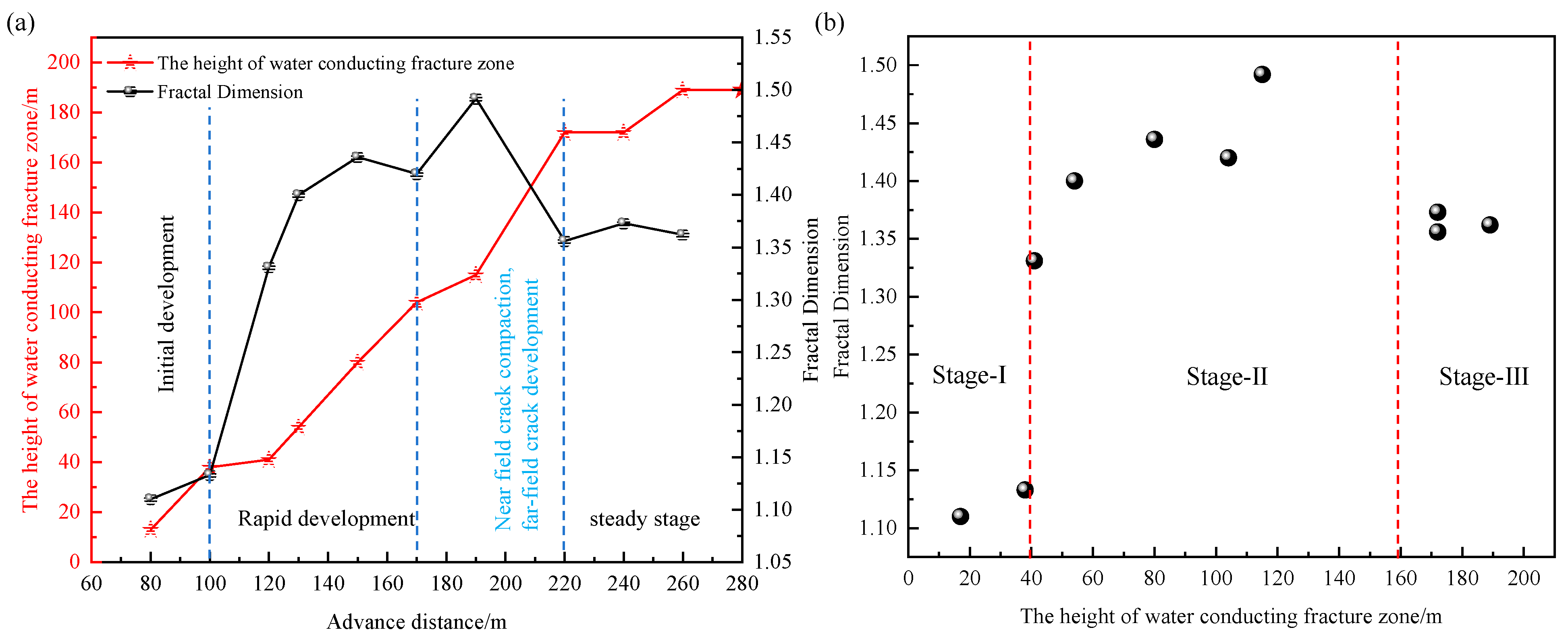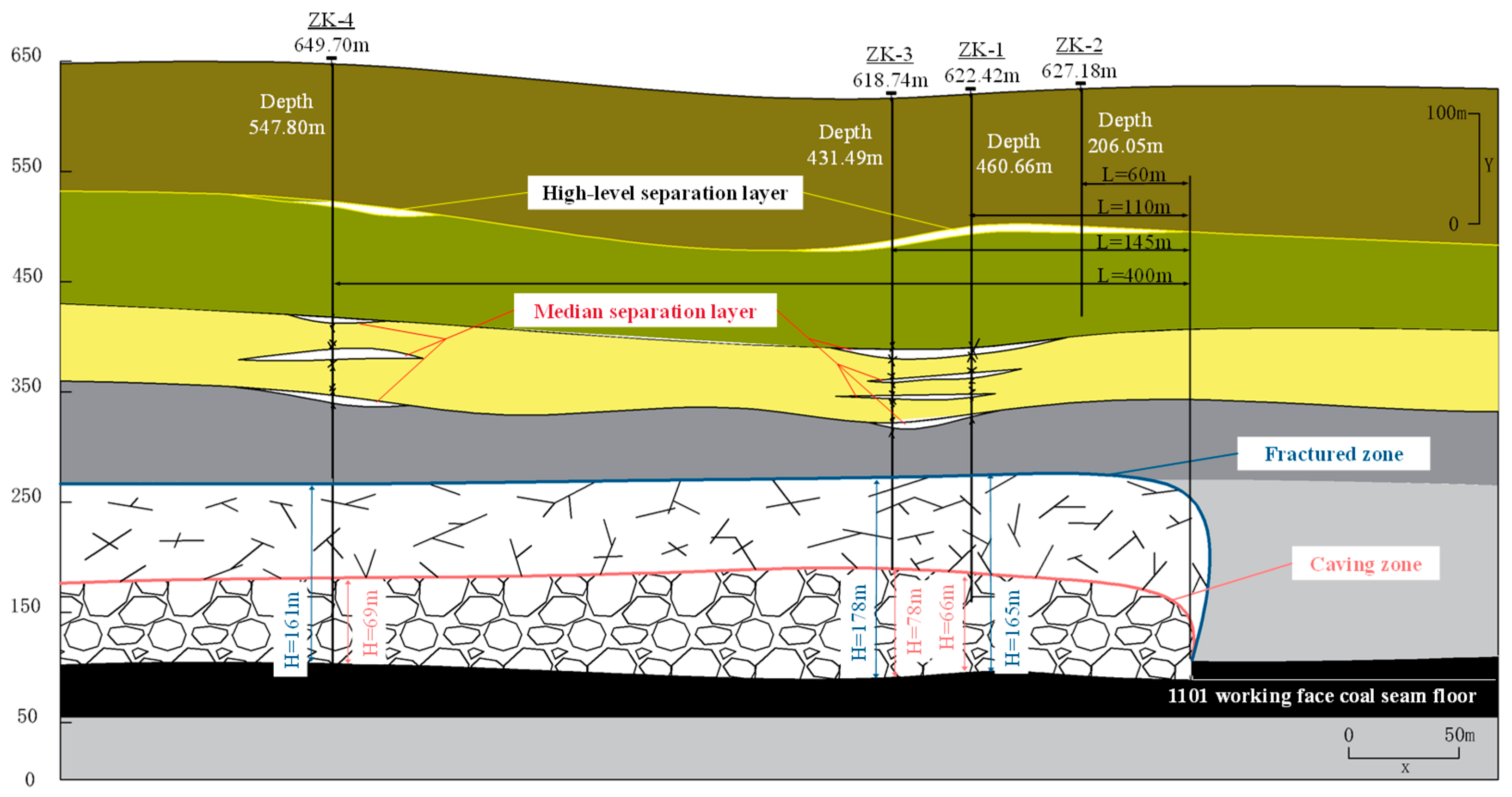Development Characteristics of Mining-Induced Fractures in Weakly Cemented Overburden During the First Layer Mining of Ultra-Thick Coal Seam: Similar Simulation and Field Measurement
Abstract
1. Introduction
2. Overview and Strata Occurrence Characteristics of WF 1101
3. Theoretical Height Prediction of the “WCFZ” in Thick Coal Seam Mining
4. Similarity Simulation Study on Fractures in WCO During Ultra-Thick Coal Seam Mining
4.1. Physical Model Construction
4.2. Fracture and Deformation Evolution Characteristics of WCO
4.3. Evolution Patterns of Overburden Displacement
4.4. Fractal Dimension Evolution Characteristics of Fractures in WCO
4.5. Evolution Patterns of the WCFZ in WCO
5. Measured Development Height of the WCFZ in WCO
5.1. Borehole Layout and Design for Exploration
5.2. Analysis of Detection Results
6. Discussion
7. Conclusions
- (1)
- TS guides and controls the evolution of mining-induced fractures in WCO. The height of the WCFZ exhibits a non-linear increasing trend with WF advancement, reaching a maximum height of 189 m and a height-to-mining ratio of 10.5 upon achieving full mining-induced stability. BST spaces primarily develop beneath TS and propagate in a jumping manner following the rupture of these strata. The height of both fractures and BST shows a significant positive correlation with the WF advancement distance.
- (2)
- Under the influence of ultra-thick coal seam mining, the overburden displacement field transitions from an “arch-shaped” to a “trapezoidal” pattern in the WF advancement direction, exhibiting symmetrical distribution. Simultaneously, due to compaction effects of the overlying strata, the subsidence on the open-off cut side and WF side is significantly less than that in the central goaf, resulting in distinct zoning characteristics in the displacement field.
- (3)
- The evolution characteristics of mining-induced fractures in WCO were quantitatively characterized using D. Under the guiding and controlling role of TS, the D of overburden fractures exhibited a “step-like” dynamic evolution pattern. The maximum D reached 1.49 after the fracture of the TS-1. Following the fracture of TS-2, near-field fractures were significantly compacted, resulting in dimension reduction. The D stabilized at 1.36–1.37 when the WF reached full mining-induced stability.
- (4)
- Field borehole detection results indicate that the interbedded zones of WCO UTCS mining are prone to failure, which partially suppresses the development height and rate of the WCFZ. The caved zone exhibits high rock fragmentation, with fragmented rock masses showing cementation-like phenomena. At the 1101 WF of Zhundong No. 2 Mine, the measured caved zone height ranges from 66 to 78 m (caving-to-mining ratio: 4.17–5.34), and the WCFZ height ranges from 161 to 178 m (fracture-to-mining ratio: 9.73–12.18).
Author Contributions
Funding
Data Availability Statement
Conflicts of Interest
References
- Wang, J.; Chen, J.; Pan, W.; Peng, B.; Deng, C. Strong ground pressure mechanism and arched face controltechnology during slicing longwall top coal caving in ultra thickcoal seam. J. China Coal Soc. 2025, 1–18. [Google Scholar] [CrossRef]
- Cai, J.L.; Tu, M.; Zhang, H.L. Deformation and instability mechanism and control technology of mining gateway for Jurassic weak-cemented soft rock roadways. J. Min. Saf. Eng. 2020, 37, 1114–1122. [Google Scholar]
- Sun, L.; Jiang, Z.; Long, Y.; Ji, Q.; Wang, Z.; Fan, Y.; Hao, Y. Influence of mesoscopic parameters of weakly cemented rocks on macroscopic mechanical properties. Sustainability 2022, 14, 13308. [Google Scholar] [CrossRef]
- Zhang, G.; Guo, G.; Wei, W.; Wang, J.; Li, H.; Du, Q. Mechanical properties and failure mechanism of the weakly cemented overburden in deep mining. Minerals 2022, 12, 1276. [Google Scholar] [CrossRef]
- Miao, S.J.; Yang, P.J.; Huang, Z.J.; Wang, H.; Liang, M.C. Effects of confining pressure on failure mechanism of porous and weakly cemented rock and compaction-damage constitutive model. J. China Univ. Min. Technol. 2023, 52, 229–240. [Google Scholar]
- Ghabraie, B.; Ren, G.; Barbato, J.; Smith, J.V. A predictive methodology for multi-seam mining induced subsidence. Int. J. Rock Mech. Min. Sci. 2017, 93, 280–294. [Google Scholar] [CrossRef]
- Wang, S.; Li, X. Dynamic distribution of longwall mining-induced voids in overlying strata of a coalbed. Int. J. Geomech. 2017, 17, 04016124. [Google Scholar] [CrossRef]
- Zhang, B.; Sun, H.; Liang, Y.; Wang, K.; Zou, Q. Characterization and quantification of mining-induced fractures in overlying strata: Implications for coalbed methane drainage. Nat. Resour. Res. 2020, 29, 2467–2480. [Google Scholar] [CrossRef]
- Meng, Q.B. Study on Structure and Mechanical Properties and Constitutive Model of Very Weakly Cemented Rock. Ph.D. Thesis, China University of Mining and Technology, Xuzhou, China, 2014. [Google Scholar]
- Wang, Z.; Li, W.; Wang, Q.; Liu, S.; Hu, Y.; Fan, K. Relationships between the petrographic, physical and mechanical characteristics of sedimentary rocks in Jurassic weakly cemented strata. Environ. Earth Sci. 2019, 78, 131. [Google Scholar] [CrossRef]
- Meng, Q.; Qian, W.; Han, L.J.; Wei, L.; Wang, C.; Zhou, X. Experimental study on formation mechanism and mechanical properties of regenerated structure of very weak cemented rock mass. Rock Soil Mech. 2020, 41, 799–812. [Google Scholar]
- Meng, Q.B.; Han, L.J.; Qiao, W.G.; Lin, D.G.; Wen, S.Y.; Zhang, J. Deformation failure characteristics and mechanism analysis of muddy weakly cemented soft rock roadway. J. Min. Saf. Eng. 2016, 33, 1014. [Google Scholar]
- Meng, Q.B.; Han, L.J.; Qiao, W.G.; Lin, D.G.; Wen, S.Y.; Zhang, J. Elastic-plastic analysis of the very weakly cemented surrounding rock considering characteristics of strain softening and expansion. J. China Univ. Min. Technol. 2018, 47, 760–767. [Google Scholar]
- Zhang, Y.; Shao, J.F.; Xu, W.Y.; Zhao, H.B.; Wang, W. Experimental and numerical investigations on strength and deformation behavior of cataclastic sandstone. Rock Mech. Rock Eng. 2015, 48, 1083–1096. [Google Scholar] [CrossRef]
- Wang, H.; Yang, T.H.; Xu, T. Acoustic emission characteristics and failure patterns of a weak cemented sandstone under uniaxial compression: Xiaojihan coal mine in Shanxi as a case. J. China Coal Soc. 2014, 43, 39–45. [Google Scholar]
- Wang, H.; Yang, T.H.; Yu, Q.L. Constitutive relationship of the sandstone from Yuheng mining area under different confining pressures. J. China Coal Soc. 2015, 40, 320–327. [Google Scholar]
- Zhao, Y.C.; Yang, T.H.; Xiao, F.K.; Wang, H.; Liu, G.; Zheng, X.; Zhou, J.R.; Shen, Z.L. The variation law of plastic strain energy of western weak cemented sandstone during cyclic loading experiment. J. China Coal Soc. 2015, 40, 1813–1819. [Google Scholar]
- Sun, L.H. Structural evolution and rock pressure activity regularity of weakly cemented strata of the large mining height work face in Western China. Chin. J. Rock Mech. Eng. 2017, 36, 1820. [Google Scholar]
- Sun, J.; Liu, J.; Han, D.; Li, N. Prediction of water-flowing fractured zone height in fully mechanized caving mining with extremely weakly cemented overburden. Mine Surv. 2012, 2, 19–21. [Google Scholar]
- Ma, D.; Duan, H.; Zhang, J.; Li, Q.; Li, Z.; Hou, W.; Du, F. Creep-erosion coupling water inrush model of weakly cemented fault rock mass. Meitan Xuebao/J. China Coal Soc. 2023, 48, 2453–2464. [Google Scholar]
- Ma, J.; Tong, X.; Li, C. Study on movement laws and permeability evolution features of mining-induced overburden in weakly cemented strata. Coal Sci. Technol. 2020, 48, 11–16. [Google Scholar]
- Fan, L.M.; Zhang, X.T.; Xiang, M.X.; Zhang, H.Q.; Shen, T.; Lin, P.X. Characteristics of ground fissure development in high intensity mining area of shallow seam in Yushenfu coal field. China Coal Soc. 2015, 40, 1442–1447. [Google Scholar]
- La Pointe, P.R. A method to characterize fracture density and connectivity through fractal geometry. Int. J. Rock Mech. Min. Sci. Geomech. Abstr. 1988, 25, 421–429. [Google Scholar] [CrossRef]
- Hatton, C.G.; Main, I.G.; Meredith, P.G. Non-universal scaling of fracture length and opening displacement. Nature 1994, 367, 160–162. [Google Scholar] [CrossRef]
- Liu, J.; Sui, W.; Duan, Z.; Ma, X. Quantitative correlation between fracture fractal and overburden deformation due to the multiple layers backfill mining. Bull. Eng. Geol. Environ. 2025, 84, 65. [Google Scholar] [CrossRef]
- Ran, Q.; Liang, Y.; Zou, Q.; Zhang, B.; Li, R.; Chen, Z.; Ma, T.; Kong, F.; Liu, H. Characteristics of mining-induced fractures under inclined coal seam group multiple mining and implications for gas migration. Nat. Resour. Res. 2023, 32, 1481–1501. [Google Scholar] [CrossRef]
- Liang, T.; Liu, X.; Wang, S. Fractal study on the crack network evolution and permeability change in mining rock mass. J. China Coal Soc. 2019, 12, 3729–3739. [Google Scholar]
- Xing, J.C.; Liang, B.; Fang, S.J.; Sun, W.J.; Ren, J.; Zhang, S.N. Study on fractal-permeability characteristics under overburden fracture recon-struction. J. China Coal Soc. 2025, 1–13. [Google Scholar] [CrossRef]
- Zhao, P.X.; Pei, W.B.; Li, S.G.; Jia, Y.Y.; Lin, H.F.; Yang, J.S. Fractal sequential evolution mechanism of fractured rock masses in adjacent goaf under layered mining of ultra-thick coal seam. J. China Univ. Min. Technol. 2024, 53, 696–709. [Google Scholar]
- Zhao, P.; Chang, Z.; Li, S.; Shao, Q.; Pei, W. Study on Time-Varying Mechanism of Energy Dissipation Structure in Depressed-Pressure Gas Transport and Storage Area of Inclined Thick Coal Seam Mining. Zhongguo Kuangye Daxue Xuebao/J. China Univ. Min. Technol. 2025, 54, 202–214. [Google Scholar]
- Song, Y.J.; Cheng, G.Q.; Guo, W.J. Study of distribution of overlying strata fissures and its porosity characteristics. Rock Soil Mech. 2011, 32, 533–536. [Google Scholar]
- Mei, F.; Shang, Y.; Kong, D.; Zhang, P.; Zhang, L.; Wu, S. DIC-based similar simulation study on the evolution patterns of mining-induced fracture, displacement and strain in close distance coal seam. J. Min. Sci. Technol. 2024, 9, 519–528. [Google Scholar]
- Cui, X.; Che, Y.; Sun, S.; Li, P.; Sun, H.; Xu, Z.; Yuan, D.; Jiang, J.; Zhao, Y.; Malinowska, A. Some key problems on estimation of height of water-conducting fractured zone for thick coal seam top coal caving. J. Min. Sci. Technol. 2025, 10, 573–583. [Google Scholar]
- Zhang, K.; Long, J.; Wang, X. Experimental study on mechanical properties of clayey mudstone under mining-induced stress paths. Coal J. 2025. [Google Scholar] [CrossRef]
- Ji, H.; Jiang, H.; Song, Z.; Liu, Z.; Tan, J.; Liu, Y.; Wu, Y. Meso-structure evolution and fracture morphology analysis of weakly cemented sandstone during water softening. Coal J. 2018, 43, 993–999. [Google Scholar]
- Li, L.; Kong, D.; Liu, Q.; Cai, H.; Chen, L. Study on law and prediction of surface movement and deformation in mountain area under repeated mining of shallow coal seam. Bull. Eng. Geol. Environ. 2023, 82, 76. [Google Scholar] [CrossRef]
- Guo, W.; Wu, D.; Guo, M.; Hu, Y.; Yang, W.; Wang, B. Multi-bed separation grouting in “three soft” thick coal seams mining and their application. Coal Sci. Technol. 2025, 53, 1–12. [Google Scholar]
- He, J.; Li, W.; Fan, K.; Qiao, W.; Wang, Q.; Li, L. A method for predicting the water-flowing fractured zone height based on an improved key stratum theory. Int. J. Min. Sci. Technol. 2023, 33, 61–71. [Google Scholar] [CrossRef]
- Zhang, C.; Ren, Z.; He, J.; Zhao, X. Fractal Evolution Characteristics of Weakly Cemented Overlying Rock Fractures in Extra-Thick Coal Seams Mining in Western Mining Areas. Fractal Fract. 2025, 9, 531. [Google Scholar] [CrossRef]
- Xie, H.P.; Yu, G.M.; Yang, L.; Zhang, Y.Z. Research on the fractal effects of crack network in overburden rock stratum. Chin. J. Rock. Mech. Eng. 1999, 18, 147–151. [Google Scholar]
- Wang, Z.; Zhou, H.; Xie, H. Research on fractal characterization of mined crack network evolution in overburden rock stratum under deep mining. Rock Soil Mech. 2009, 30, 2403–2408. [Google Scholar]
- Ling, C.; Liu, B.; Zhang, C.; Teng, T.; Zhang, K.; Sun, B.; Zhou, J. Fractal characteristics of overburden rock fractures and their impact on ground fissures in longwall coal mining. Fractal Fract. 2023, 7, 699. [Google Scholar] [CrossRef]
- Zhou, H.W.; Zhang, T.; Xue, D.J.; Xue, J.H. Evolution of mining-crack network in overburden strata of longwall face. J. China Coal Soc. 2012, 36, 1957–1962. [Google Scholar]
- Guo, W.; Lou, G.; Zhao, B. Study on the height of water-conductive fracture zone in alternate overburden of soft and hard with top coal caving mining in Lugou coal mine. J. Min. Saf. Eng. 2019, 36, 519–526. [Google Scholar]
- Li, J.; Wang, D.; Li, L.; Guo, W. Comparative study on development characteristics of high-strength mining fissures in different overburden types. Coal Sci. Technol. 2023, 49, 9–15. [Google Scholar]
- Chen, L.; Wu, B.; Xu, X.K.; Shang, R. Determination of overburden failure height in alternate strata of mudstone and sandstone with fully mechanized caving method. J. Min. Saf. Eng 2017, 34, 431–436. [Google Scholar]














| Empirical Equation | Result | Reference | ||
|---|---|---|---|---|
| Height of the caving zone | (1) | 54~72 | [11] | |
| (2) | 11.03~14.03 | [12,13] | ||
| (3) | 8.32~10.72 | [12,13] | ||
| (4) | 31.24~40.76 | [15] | ||
| Height of WCFZ | (5) | 25.61~33.61 | [12,13] | |
| (6) | 47.43 | [12,13] | ||
| (7) | 15.37~21.37 | [12,13] | ||
| (8) | 106.62~143.55 | [14] | ||
| (9) | 116.88~133.30 | [15] | ||
| (10) | 155.59 | [16] | ||
| (11) | 268.10 | [17] | ||
| (12) | 101.76~117.36 | [21] | ||
| No. | Rock Layer | Field Floor Depth/m | Field Thickness/m | Thickness/cm | Water Content/kg | Fine Sand/kg | Lime/kg | Gypsum/kg | Mix Ratio No. |
|---|---|---|---|---|---|---|---|---|---|
| 1 | Silty mudstone | 343.99 | 25.44 | 12.72 | 17.10 | 201.83 | 22.71 | 2.52 | 891 |
| 2 | Siltstone | 348.09 | 4.10 | 2.05 | 2.76 | 32.02 | 3.20 | 1.37 | 773 |
| 3 | Fine sandstone | 352.66 | 4.57 | 2.29 | 2.95 | 36.34 | 3.63 | 0.91 | 882 |
| 4 | Medium-grained sandstone | 363.53 | 10.87 | 5.44 | 7.31 | 83.23 | 12.48 | 1.39 | 691 |
| 5 | Silty mudstone | 422.98 | 59.45 | 29.73 | 39.96 | 471.73 | 53.07 | 5.89 | 891 |
| 6 | Carbonaceous mudstone | 426.21 | 3.24 | 1.62 | 2.24 | 26.46 | 2.32 | 0.99 | 873 |
| 7 | Silty mudstone | 435.57 | 9.35 | 4.68 | 6.29 | 74.26 | 8.35 | 0.93 | 891 |
| 8 | Fine sandstone | 438.77 | 3.20 | 1.6 | 2.06 | 25.39 | 2.54 | 0.64 | 882 |
| 9 | Silty mudstone | 489.33 | 50.56 | 25.82 | 34.70 | 409.69 | 46.09 | 5.11 | 891 |
| 10 | Siltstone | 494.95 | 5.62 | 2.81 | 3.78 | 43.89 | 4.39 | 1.88 | 773 |
| 11 | Coarse-grained sandstone | 500.10 | 5.15 | 2.58 | 3.32 | 40.20 | 4.02 | 1.02 | 882 |
| 12 | Silty mudstone | 508.42 | 8.32 | 4.16 | 5.59 | 66.01 | 7.43 | 0.82 | 891 |
| 13 | Fine sandstone | 513.40 | 4.98 | 2.49 | 3.21 | 39.51 | 3.95 | 0.99 | 882 |
| 14 | Argillaceous siltstone | 521.89 | 8.49 | 4.25 | 5.47 | 67.43 | 6.74 | 1.69 | 882 |
| 15 | Coarse-grained sandstone | 524.89 | 3.00 | 1.5 | 1.93 | 23.80 | 2.38 | 0.60 | 882 |
| 16 | Coal Seam B1 | 578.89 | 55.00 | 26.25 | 36.31 | 428.75 | 37.52 | 16.08 | 873 |
| 17 | Argillaceous siltstone | 588.69 | 8.80 | 4.4 | 5.67 | 69.81 | 6.98 | 1.75 | 882 |
| 18 | Fine sandstone | 598.83 | 10.14 | 5.07 | 7.34 | 90.44 | 9.04 | 2.26 | 882 |
| 19 | Coarse-grained sandstone | 608.99 | 10.16 | 5.08 | 6.31 | 77.74 | 7.77 | 1.95 | 882 |
| Borehole No. | Depth/m | Mining Height/m | Height of Caved Zone/m | Caving-to-Mining Ratio | Height of WCFZ/m | Fracture-to-Mining Ratio |
|---|---|---|---|---|---|---|
| ZK-1 | 460.66 | 14.62 | 66 | 4.51 | 165 | 11.29 |
| ZK-3 | 431.49 | 14.62 | 78 | 5.34 | 178 | 12.18 |
| ZK-4 | 547.80 | 16.54 | 69 | 4.17 | 161 | 9.73 |
| Method | Height of Caved Zone/m | Relative Error | Caving-to-Mining Ratio | Method | Height of WCFZ/m | Relative Error | Caving-to-Mining Ratio |
|---|---|---|---|---|---|---|---|
| Field measurements | 66~78 | - | 4.17~5.34 | - | 161~178 | - | 9.73~12.18 |
| Equation (1) | 43.86~72 | −33.55%~−7.69% | 3.00~4.35 | Equation (5) | 25.05~33.61 | −84.44%~−81.12% | 1.71~2.03 |
| Equation (2) | 10.42~14.03 | −84.21%~−82.01% | 0.71~0.96 | Equation (6) | 43.24~47.43 | −73.15%~−73.36% | 2.96~2.87 |
| Equation (3) | 7.65~10.72 | −88.42%~−86.25% | 0.52~0.65 | Equation (7) | 15.03~21.37 | −90.67%~−88.00% | 1.03~0.93 |
| Equation (4) | 27.04~40.76 | −59.02~−47.73% | 1.85~2.46 | Equation (8) | 91.12~143.55 | −43.41%~−19.35% | 6.23~8.68 |
| Equation (9) | 101.37~133.30 | −37.04%~−25.11% | 6.93~8.06 | ||||
| Equation (10) | 126.87~155.59 | −21.20%~−12.59% | 8.68~9.41 | ||||
| Equation (11) | 251.29~268.10 | 56.08%~50.62% | 17.19~16.21 | ||||
| Equation (12) | 87.24~117.36 | −45.81%~−34.07% | 5.97~7.10 | ||||
| Similarity simulation | - | 189 | −6.18% | 10.5 |
Disclaimer/Publisher’s Note: The statements, opinions and data contained in all publications are solely those of the individual author(s) and contributor(s) and not of MDPI and/or the editor(s). MDPI and/or the editor(s) disclaim responsibility for any injury to people or property resulting from any ideas, methods, instructions or products referred to in the content. |
© 2025 by the authors. Licensee MDPI, Basel, Switzerland. This article is an open access article distributed under the terms and conditions of the Creative Commons Attribution (CC BY) license (https://creativecommons.org/licenses/by/4.0/).
Share and Cite
Deng, Y.; Pan, W.; Liu, S.; Cui, B.; Zhang, K. Development Characteristics of Mining-Induced Fractures in Weakly Cemented Overburden During the First Layer Mining of Ultra-Thick Coal Seam: Similar Simulation and Field Measurement. Fractal Fract. 2025, 9, 718. https://doi.org/10.3390/fractalfract9110718
Deng Y, Pan W, Liu S, Cui B, Zhang K. Development Characteristics of Mining-Induced Fractures in Weakly Cemented Overburden During the First Layer Mining of Ultra-Thick Coal Seam: Similar Simulation and Field Measurement. Fractal and Fractional. 2025; 9(11):718. https://doi.org/10.3390/fractalfract9110718
Chicago/Turabian StyleDeng, Yupei, Weidong Pan, Shiqi Liu, Bo Cui, and Kunming Zhang. 2025. "Development Characteristics of Mining-Induced Fractures in Weakly Cemented Overburden During the First Layer Mining of Ultra-Thick Coal Seam: Similar Simulation and Field Measurement" Fractal and Fractional 9, no. 11: 718. https://doi.org/10.3390/fractalfract9110718
APA StyleDeng, Y., Pan, W., Liu, S., Cui, B., & Zhang, K. (2025). Development Characteristics of Mining-Induced Fractures in Weakly Cemented Overburden During the First Layer Mining of Ultra-Thick Coal Seam: Similar Simulation and Field Measurement. Fractal and Fractional, 9(11), 718. https://doi.org/10.3390/fractalfract9110718







